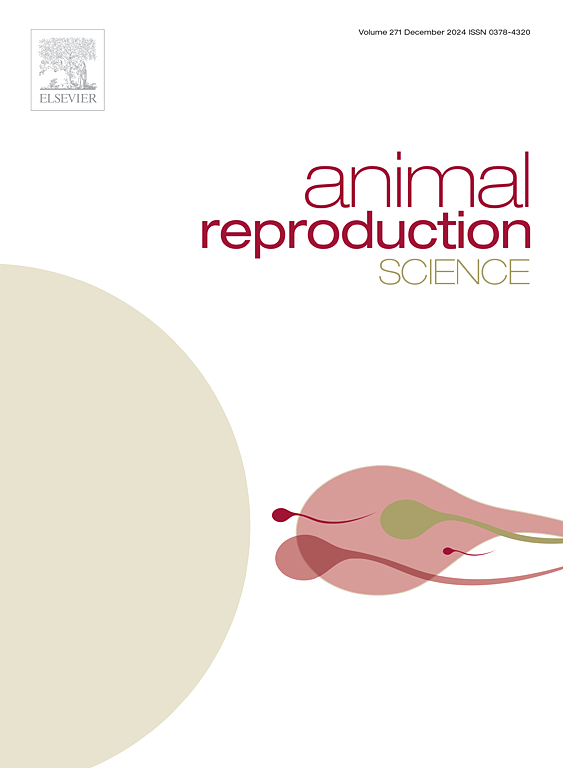内镜引导下经宫颈置管对犬子宫内膜炎和正常子宫细胞学和细菌学取样的诊断价值
IF 2.2
2区 农林科学
Q1 AGRICULTURE, DAIRY & ANIMAL SCIENCE
引用次数: 0
摘要
本研究的目的是:1)评价内镜引导下经宫颈导管(TCC)子宫内膜细胞学检查对犬子宫内膜炎和正常子宫的诊断价值;2)确定TCC检测子宫细菌生长的敏感性和特异性;3)比较阴道和子宫细菌学检查结果。选择卵巢子宫切除术前,对10只青春期后母狗进行阴道及输卵管癌细菌学和细胞学检查。术后行子宫直接细菌学取样及全层活检。子宫内膜细胞学和全层活检结果以及细菌学结果之间的一致性使用Cohen’s kappa (κ)系数进行评估。计算细胞学和细菌学培养的敏感性和特异性。TCC细胞学与组织病理学的一致性为k = 0.62,P <; 0.05。TCC细胞学敏感性为66 %,特异性为100 %,P <; 0.01。TCC与子宫直接细菌学取样的符合性k = 0.60,P = 0.05。TCC细菌学样品的敏感性为100 %,特异性为75 %,P <; 0.05。相反,阴道和TCC或直接子宫细菌分析的一致性分别为k = 0.05,P >; 0.1和k = 0.1,P >; 0.1。本研究强调了内镜引导下TCC对正常母狗和子宫内膜炎母狗细胞学和细菌学取样的诊断价值。阴道和子宫细菌学结果之间的不一致证实了这些器官之间存在不同的微生物群。本文章由计算机程序翻译,如有差异,请以英文原文为准。
Diagnostic value of endoscopically guided transcervical catheterization for cytological and bacteriological sampling in canine endometritis and normal uterus
The aims of this study were: 1) To evaluate the diagnostic value of endometrial cytological samples obtained by endoscopically guided transcervical catheterization (TCC) in canine endometritis and normal uterus; 2) To determine the sensitivity and specificity of TCC for the identification of uterine bacterial growth; 3) To compare vaginal and uterine bacteriological findings. Before elected ovariohysterectomy, vaginal and TCC bacteriological and cytological samples were obtained in ten post-pubertal bitches. After surgery, direct uterine bacteriological sampling and full-thickness biopsy were also carried out. The agreement between endometrial cytology and full-thickness biopsy and between bacteriological results were assessed using Cohen’s kappa (κ) coefficient. Sensitivity and specificity were calculated for cytology and bacteriology cultures. The agreement between the TCC cytology and histopathology was k = 0.62, P < 0.05. Sensitivity of TCC cytology was 66 % and specificity was 100 %, P < 0.01. The agreement between TCC and direct uterine bacteriological sampling was k = 0.60, P = 0.05. Sensitivity of TCC bacteriological samples was 100 % and specificity was 75 %, P < 0.05. Conversely, the agreement between vaginal and TCC or direct uterine bacterial analyses were k = 0.05, P > 0.1 and k = 0.1, P > 0.1, respectively. This study highlights the diagnostic value of endoscopically guided TCC for cytological and bacteriological sampling in normal bitches and those suffering from endometritis. The poor agreement between vaginal and uterine bacteriological results confirms the presence of different microbiota between these organs.
求助全文
通过发布文献求助,成功后即可免费获取论文全文。
去求助
来源期刊

Animal Reproduction Science
农林科学-奶制品与动物科学
CiteScore
4.50
自引率
9.10%
发文量
136
审稿时长
54 days
期刊介绍:
Animal Reproduction Science publishes results from studies relating to reproduction and fertility in animals. This includes both fundamental research and applied studies, including management practices that increase our understanding of the biology and manipulation of reproduction. Manuscripts should go into depth in the mechanisms involved in the research reported, rather than a give a mere description of findings. The focus is on animals that are useful to humans including food- and fibre-producing; companion/recreational; captive; and endangered species including zoo animals, but excluding laboratory animals unless the results of the study provide new information that impacts the basic understanding of the biology or manipulation of reproduction.
The journal''s scope includes the study of reproductive physiology and endocrinology, reproductive cycles, natural and artificial control of reproduction, preservation and use of gametes and embryos, pregnancy and parturition, infertility and sterility, diagnostic and therapeutic techniques.
The Editorial Board of Animal Reproduction Science has decided not to publish papers in which there is an exclusive examination of the in vitro development of oocytes and embryos; however, there will be consideration of papers that include in vitro studies where the source of the oocytes and/or development of the embryos beyond the blastocyst stage is part of the experimental design.
 求助内容:
求助内容: 应助结果提醒方式:
应助结果提醒方式:


